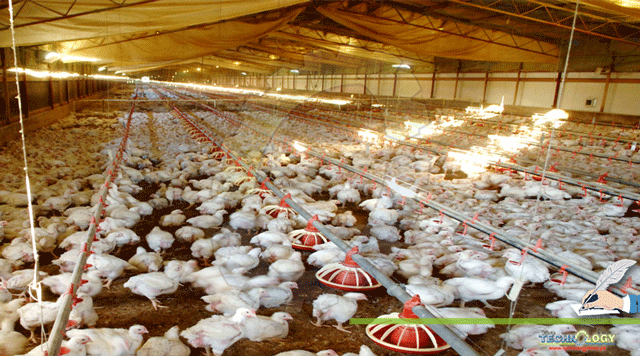Heat stress occurs when the bird’s core body temperature increases to fatal temperatures because of poor heat loss and limited coping means. Environmental temperature and humidity play a role in heat stress.

By Dr. Hafeez ur Rehman Ali Khera, Dr. Atif Rehman, Prof.Dr.Muhammad Asif Raza, Prof.Dr.Junaid Ali Khan, Abdul Samad
When Hyperthermia occur?
Heat stress occurs when the bird’s core body temperature increases to fatal temperatures because of poor heat loss and limited coping means. Environmental temperature and humidity play a role in heat stress. Thus it is key to measure both the temperature and humidity in the barn.
Temperature
The thermo neutral zone is the range of environmental temperatures that an organism can maintain their body temperature. For most poultry, the thermo neutral zone is between 60 and 75 F. This zone represents the temperature range where heat production is lowest. As temperatures increase towards 85 F, the birds will adjust their behavior and decrease feed intake and production. These changes help prevent the bird’s core body temperature from increasing. When air temperature increases towards 100 F, the birds’ core body temperatures will increase to lethal temperatures unless relief is provided. These temperatures can shift depending on humidity, care and building conditions.
Humidity
High humidity decreases poultry heat loss from the lungs, which makes the birds more prone to heat stress. For older turkeys, temperatures at 85 F with humidity above 50 percent places turkeys in the danger zone. At 90 F and 50 percent humidity the risk increases to extreme. If misting or fogging at low humidity, monitor relative humidity to prevent excess moisture in the air that can worsen heat stress conditions. Signs of heat stress
Signs of heat stress
As air temperatures increase towards 85 F, the bird will try to lose heat through evaporative cooling, panting. Panting creates more heat through muscle activity. As a result, the bird will increase its water intake, but not enough to keep up with the losses through respiration and urine excretion. Without relief, the changes will worsen and the bird may die.
Solution to control Heat Stress in Poultry
Providing ventilation
In most cases, you can manage heat in your flock through air flow. Airflow at the birds’ level is key to removing bird heat. Increasing ventilation to remove heat from the birds should be your first priority. However, some cases exist where ventilation is limiting. Naturally-ventilated barns are at risk of heat stress if the air is calm and supplemental fans are not present. Mechanically-ventilated barns can also be at risk if barns lack ventilation capacity and air mixing for the size and number of birds present.
Feeding
Most often, birds are hungriest in the morning and will tend to fill up. This will make them more prone to heat stress in the afternoon. Withdrawing feed birds six hours before peak warm temperatures in the afternoon can lower the risk of heat stress. You can reintroduce the feed after peak temperatures have started to decline. Birds can then feed during night time hours when we expect cooler temperatures to occur. Have the feeders full when lowering the feed line. You can use lighting during nighttime (midnight) feeding to allow intake. You may notice some body weight loss depending on how often you use this feeding method. Thus only follow this feed method when you expect heat stress temperatures.
Managing water
During heat stress, birds will increase their water intake by 2 to 4 times their normal intake. Sufficient water space, operating waterers and cool water temperatures will encourage the birds to drink. Flush water lines and waterers routinely to keep the water fresh and cool.
Using electrolytes
You can add electrolytes to your flock’s drinking water for up to three days. Heat stress causes increased loss of several minerals including potassium, sodium, phosphorus, magnesium and zinc. Potassium chloride electrolytes appear to increase water intake when provided in drinking water at 0.6 percent concentration. It has been generally more effective than other potassium and sodium salts. You should start providing electrolytes prior to the heat stress period.
Providing sodium bicarbonate
Sodium bicarbonate in the feed or use of carbonated water is especially useful for hens in egg production. Panting and carbon dioxide release can change the acid-base balance in poultry, but also the bicarbonate available for eggshell formation. Thus sodium bicarbonate can help lessen these changes.
Supplementing vitamins
Supplementing drinking water with vitamins (A, D, E and B complex) can be effective at tackling heat stress mortality in broilers. In breeding poultry, vitamin C can effectively moderate warm temperature declines in egg production and eggshell quality in laying hens, and sperm production in breeder males.
Mitigating heat stress for the birds
Improved house design, including better insulation and ventilation, can help to mitigate the undesirable physiological effects of heat stress but building modifications can be prohibitively expensive. A variety of remedial nutritional steps can also be taken, depending on the local situation. These include ensuring an optimum drinking water temperature, the use of highly digestible feed proteins, choosing the right anticoccidial program (as some anticoccidials decrease the capability to cope adequately with high ambient temperatures), the use of appropriate electrolytes and/or antioxidants and even the application of specific organic trace elements – but often these can be relatively ineffective tweaks that will not necessarily address one of the fundamental physiological effects of heat stress in poultry.
Intestinal integrity compromised
There is a strong link between heat stress and intestinal inflammation with far-reaching consequences for intestinal barrier function. As evidenced by various research papers, heat stress compromises intestinal integrity, in conjunction with increased levels of pro-inflammatory cytokines, stress hormones (cortisol) and reactive oxygen species, leading to suboptimal nutrient uptake and poor performance. Indeed, intestinal mucosal barrier dysfunction, inflammatory responses and an enhanced risk of bacterial translocation from the intestinal lumen into the bloodstream have all been identified as major symptoms in birds subjected to heat stress.
Feed additives to reduce heat stress
Consequently, a number of feed additives known for their anti-inflammatory effects have been investigated for their potential to reduce this heat stress-induced intestinal inflammation. For example, isoquinoline alkaloids (IQs) have been shown to boost growth in broilers due to their anti-inflammatory properties. It is logical, therefore, to try to assess their ability and potential to mitigate intestinal inflammation caused by heat stress.
Study on a new plant-derived feed additive
In a recent trial at Tohoku University in Japan, 360 male Ross 308 broiler chickens were divided into 2 treatment groups – a control and a group fed a diet supplemented with a standardised blend of plant-derived IQs. The birds were kept under thermoneutral conditions until day 14. Thereafter, a 2×2 factorial design was used to determine the effect of the thermoneutral control group versus the group under heat stress (factor 1) and the effect of no feed additive versus supplementation with IQs (factor 2). Fluorescin isothiocyanate (FITC)-dextran in blood plasma was measured on day 42 to assess any impact of heat stress on gut integrity. This is because high levels of FITC-dextran indicate an impaired gut barrier function.
Other practices
- Delay activity in the barn such as moving of birds or litter conditioning.
- Provide shade for pastured poultry or decrease sun exposure in the barn
References
University of Minnesota Extensions
Poultry World

Authors:
Dr. Hafeez ur Rehman Ali Khera, Dr. Atif Rehman, Prof.Dr.Muhammad Asif Raza, Prof.Dr.Junaid Ali Khan, Abdul Samad
Affiliation Address
Faculty of Veterinary and Animal Sciences, MNS University of Agriculture Multan